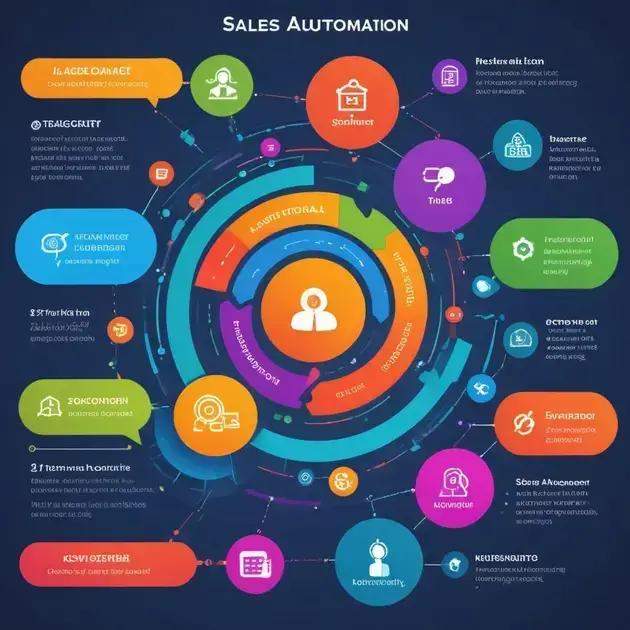Sales automation software streamlines the sales process by automating repetitive tasks, enhancing efficiency, and improving lead management. By leveraging these tools, businesses can focus on closing deals and boosting revenue, while also benefiting from valuable insights and improved customer communication.
Sales automation software is transforming the landscape of how businesses approach lead management and deal closures. By leveraging technology, companies can enhance efficiency, improve tracking, and ultimately drive sales growth. In this post, we’ll delve into the functionality of sales automation software, highlight its benefits, and guide you through the process of selecting and implementing the right tools for your organization.
What is Sales Automation Software?
Sales automation software streamlines the sales process by using technology to automate repetitive tasks, such as lead management and communication tracking. These tools help sales teams manage their pipelines more effectively and focus on closing deals.
Definition of Sales Automation Software
At its core, sales automation software is designed to enhance productivity. It assists sales professionals in handling daily tasks and organizing interactions with prospects. By doing so, it allows for improved efficiency and better customer engagement.
Key Features of Sales Automation Software
Common features include lead tracking, email automation, pipeline management, and reporting analytics. For example, email automation enables you to send follow-ups without manual effort, whereas pipeline management provides visibility into where each lead stands in your sales process.
Types of Sales Automation Tools
There are various types of sales automation tools available, including CRM systems, email marketing platforms, and sales engagement tools. Each type addresses different needs within the sales process, allowing teams to select solutions that best fit their operations.
Benefits of Using Sales Automation Software
Utilizing sales automation software can lead to significant improvements in sales performance. By automating mundane tasks, teams can spend more time engaging with customers and developing strategies that drive revenue growth.
Top Benefits of Using Sales Automation

Using sales automation software provides numerous benefits that can transform your sales processes. Here are some of the key advantages:
Increased Efficiency
Sales automation tools help eliminate repetitive tasks, allowing sales teams to focus on high-value activities. With automated lead tracking and communication, teams can spend less time on administrative work.
Improved Lead Management
These tools allow for better organization and tracking of leads through the sales funnel. By automatically logging interactions, sales professionals can get insights into customer behaviors and preferences, which aids in personalized outreach.
Enhanced Communication
Sales automation software provides features like automated email responses and follow-up reminders, ensuring timely interactions with prospects. This improves engagement rates and customer satisfaction.
Data-Driven Decisions
With comprehensive reporting and analytics, sales automation software gives teams access to valuable data. This information helps in making informed decisions and adjusting sales strategies to meet targets effectively.
Increased Revenue
Overall, the efficiency and effectiveness gained from using sales automation often lead to increased sales. By closing deals faster and nurturing leads more effectively, businesses can boost their revenue growth significantly.
How to Choose the Right Sales Automation Tool
Choosing the right sales automation tool for your business is crucial for maximizing productivity and efficiency. Here are some steps to help guide your decision:
Identify Your Needs
Start by assessing what specific challenges you want the sales automation software to address. This could include tasks like lead tracking, customer communication, or generating reports.
Evaluate Features
Check the features offered by different tools. Look for essential functionalities such as CRM integration, email automation, and analytics. Prioritize features that align with your business goals.
Consider User Experience
A user-friendly interface can significantly improve adoption rates among your sales team. Test different tools to see which ones are easy to navigate and require minimal training.
Check Integration Capabilities
Make sure that the sales automation tool can integrate seamlessly with your existing systems, such as marketing tools or customer databases. This ensures you can leverage data across platforms effectively.
Read Reviews and Get Feedback
Research user reviews and seek feedback from other businesses in your industry. This can provide valuable insights into the reliability and performance of the tools you are considering.
Implementation Steps for Sales Automation

Implementing sales automation can greatly enhance your business processes. Here are the steps to guide you through the implementation:
1. Assess Your Current Processes
Begin by analyzing your current sales processes to identify what tasks could benefit from automation. Understanding where inefficiencies lie will help you target the right areas for improvement.
2. Define Your Goals
Set clear objectives for what you want to achieve with sales automation. Whether it’s increasing lead conversion rates or reducing response times, having specific goals will guide your implementation strategy.
3. Choose the Right Tools
Research and select a sales automation tool that fits your needs. Look for features that align with your goals and ensure the tool integrates well with your existing software.
4. Train Your Team
Once a tool is selected, offer comprehensive training to your sales team. Proper training is essential to ensure that everyone is comfortable using the new system and understands its benefits.
5. Monitor and Optimize
After implementing sales automation, continually monitor its performance. Use analytics to assess its impact on your sales process, and be prepared to make adjustments to optimize its effectiveness over time.
Future Trends in Sales Automation Software
The field of sales automation software is rapidly evolving. Here are some key trends to watch for in the future:
1. Artificial Intelligence and Machine Learning
AI and machine learning will play a significant role in the advancement of sales automation. These technologies can analyze data patterns, predict customer behaviors, and personalize sales strategies effectively.
2. Integration with Other Tools
Future sales automation tools will increasingly focus on seamless integration with other business software, such as marketing automation and CRM systems. This will provide a more holistic view of customer interactions and improve overall efficiency.
3. Increased Use of Mobile Technology
As remote work continues to rise, mobile sales automation applications will become more essential. Sales teams will rely on mobile solutions to manage leads and track performance while on the go.
4. Enhanced Analytics and Reporting
Sales automation tools will offer enhanced analytics capabilities, allowing businesses to gain deeper insights into their sales processes. These insights will enable data-driven decision-making and improved sales strategies.
5. Focus on Customer Experience
Future trends indicate a stronger emphasis on improving customer experience through automation. Tools will be designed to create personalized and timely interactions that enhance customer satisfaction and loyalty.
In conclusion: Embracing Sales Automation
Sales automation software offers many benefits, making it easier for businesses to manage their sales processes. By automating routine tasks, your team can focus on what truly matters: closing deals and building relationships with customers.
With the right tools and a clear implementation strategy, sales automation can improve efficiency, enhance customer experiences, and drive increased revenue.
As you look to the future, keeping an eye on trends like AI integration and mobile technology will help you stay ahead in a competitive market.
Don’t hesitate to explore sales automation solutions to unlock your business’s full potential.
FAQ – Frequently Asked Questions about Sales Automation Software
What is sales automation software used for?
Sales automation software is designed to streamline the sales process by automating repetitive tasks like lead tracking, communication, and reporting.
How can sales automation benefit my business?
It can increase efficiency, improve lead management, enhance communication, provide valuable data insights, and ultimately boost revenue.
What features should I look for in sales automation software?
Look for features such as CRM integration, email automation, analytics, and user-friendly interfaces to maximize productivity.
How do I implement sales automation in my team?
Start by assessing current processes, defining goals, choosing the right tools, training your team, and continually monitoring results.
What trends should I watch in sales automation?
Monitor trends like AI integration, mobile technology use, enhanced analytics, and a focus on improving customer experiences.
Is sales automation suitable for small businesses?
Yes, sales automation can benefit small businesses by streamlining operations and helping them compete more effectively in their markets.




